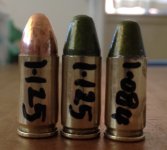Hi All.
Forgive the newby post, but would very much appreciate a few thoughts on the pressure differences likely from different OAL's for a 9mm.
I am aware that a reduction in OAL causes an increase in pressure, but how much of a difference exactly is required to affect things?
My example -
Was just setting up to load for my new Kimber when it became apparent that it wasn't nearly as 'easy going' as my 92A1 when it comes to OAL!!
I've been using 124gr LRN which my data tells me needs to be a min. OAL of 1.15" (which I know is pretty common...), except the Kimber doesn't like them until they're more like 1.125".
Now we're only talking .025", but I am trying to work out whether it is just a case of reducing the load to compensate or just switch to something like 115gr which I can run at around 1.100" to 1.125" which will then suit both guns.
A bit long winded I know, but any wisdom would be appreciated!!
Cheers, Seb
Forgive the newby post, but would very much appreciate a few thoughts on the pressure differences likely from different OAL's for a 9mm.
I am aware that a reduction in OAL causes an increase in pressure, but how much of a difference exactly is required to affect things?
My example -
Was just setting up to load for my new Kimber when it became apparent that it wasn't nearly as 'easy going' as my 92A1 when it comes to OAL!!
I've been using 124gr LRN which my data tells me needs to be a min. OAL of 1.15" (which I know is pretty common...), except the Kimber doesn't like them until they're more like 1.125".
Now we're only talking .025", but I am trying to work out whether it is just a case of reducing the load to compensate or just switch to something like 115gr which I can run at around 1.100" to 1.125" which will then suit both guns.
A bit long winded I know, but any wisdom would be appreciated!!
Cheers, Seb

